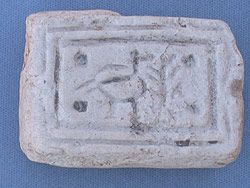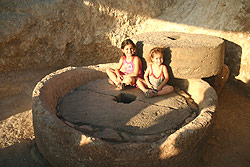
Stone seal engraved with a figure of a ‘bird and an olive branch’,
During the latter part of the war in the north archaeologists of the Israel Antiquities Authority uncovered stone seals engraved with a figure of a ‘bird and an olive branch’ –
is this a message from the past or a logo?
In the course of routine development work during the construction of a new neighborhood next to the settlement of Allone Abba (north of Tivon), inspectors of the Antiquities Authority’s were surprised when they discovered a very beautiful olive press that was installed inside of a rock-hewn cave. The olive press, which was used for the industrial production of olive oil, was in use more than 2,000 years ago. A stone seal with a drawing of a bird and an olive branch was discovered on the floor of the cave. The excavations began prior to the war and were recently completed. Due to the beauty and importance of the site the Antiquities Authority recommends preserving it as an educational and cultural site.

Olive press next to Allone Abba
An olive oil plant, more than 2,000 years old, for manufacturing olive oil on an industrial scale, was exposed in excavations conducted by the Antiquities Authority next to Allone Abba. The olive press, consisting of a number of installations, was installed inside of a rock-hewn cave. On one side of the cave was the basin (yam), on which the olives were crushed, on top of which was a revolving stone wheel (memel) that was rotated by an animal. On the other side of the cave was a press consisting of a pair of stone piers (betulot) between which the baskets of olives were placed, and the press beam (the bad – Hebrew: a large branch after which an olive press – beit bad – is named) that was set on top of the baskets. Four heavy stone weights were suspended on the beam and thus the oil was extracted from the olives.
The finds from the olive oil plant indicate that it was first used in the Hellenistic period (4th-1st centuries BCE) and continued to operate in the Early Roman period (1st century CE). Bone spoons used for scooping up the olive paste from the basin and a stone seal engraved with a bird and an olive branch, the purpose of which has yet to be ascertained, were found on the floor of the cave.
The work at Allone Abba is being directed by Leea Porat, an archaeologist with the Antiquities Authority, who reports that the excavations began during the war in the north and each time the sirens sounded the excavators hid in a rock shelter and in the trenches that were dug there. “Now that the war is behind us we can complete the excavation. Due to the beauty and importance of the site the Antiquities Authority will not allow it to be built upon and will recommend preserving the remains and incorporating them as an open archaeological garden in the new neighborhood to be built”, she said. The residents of Allone Abba were invited by the Galilee Archaeological Center of the Antiquities Authority to visit the site and were provided with explanations about the unique finds.
Additional Articles ...